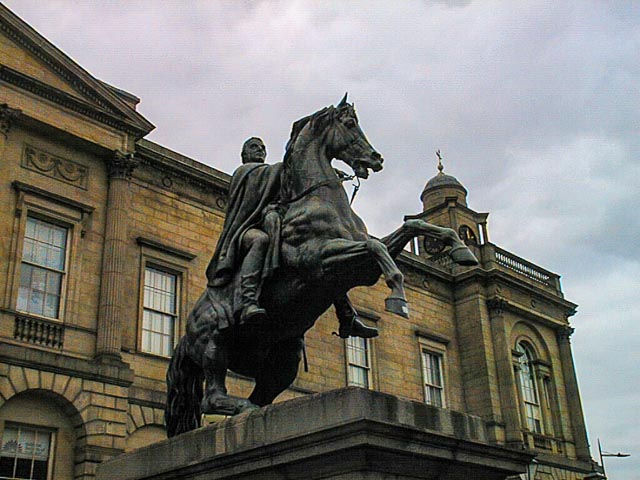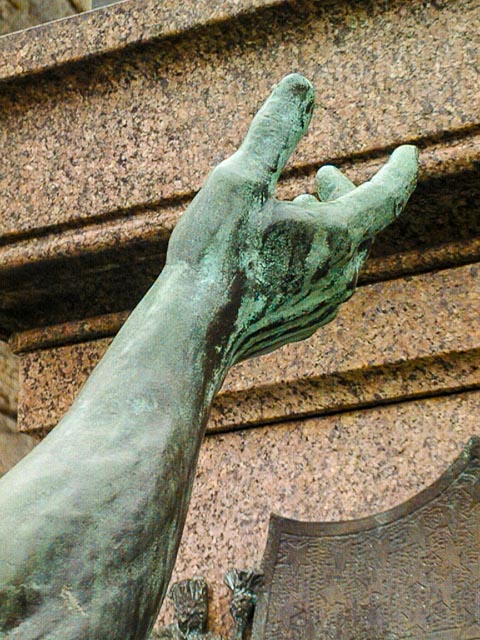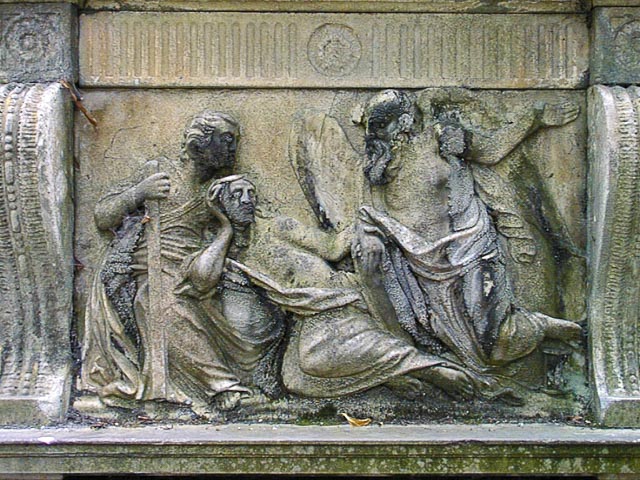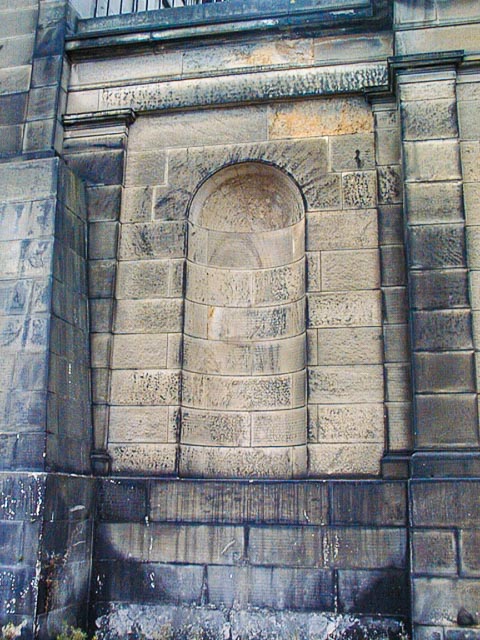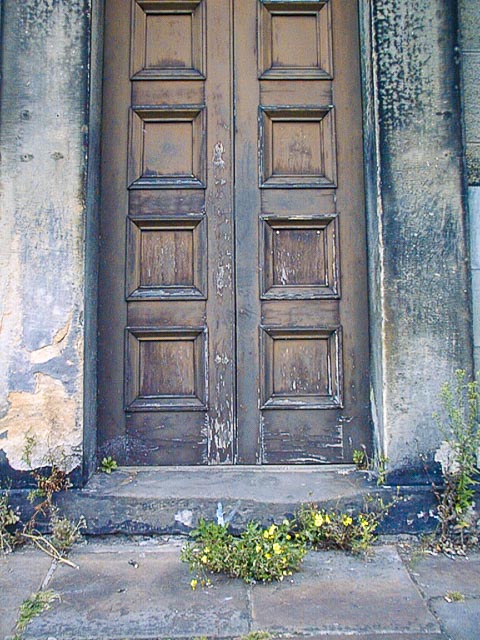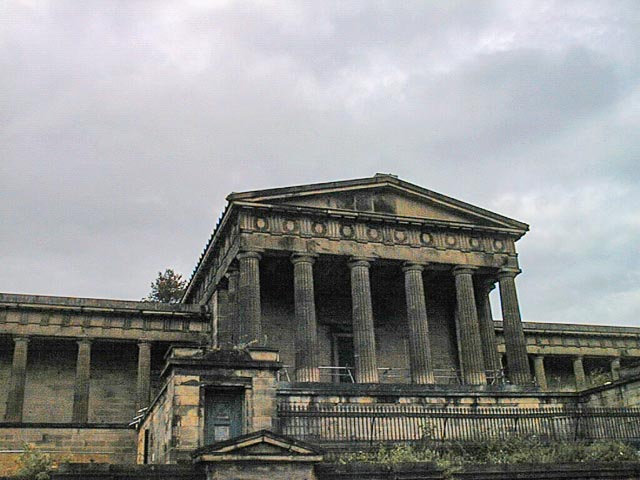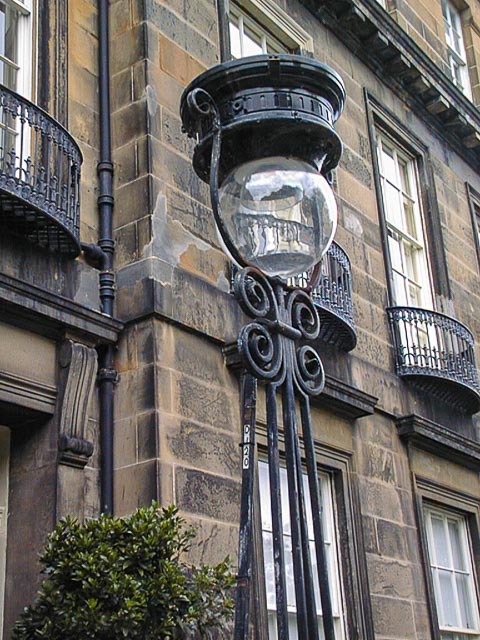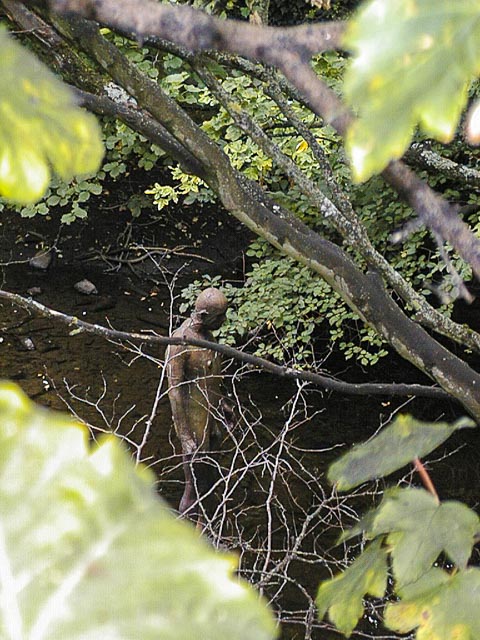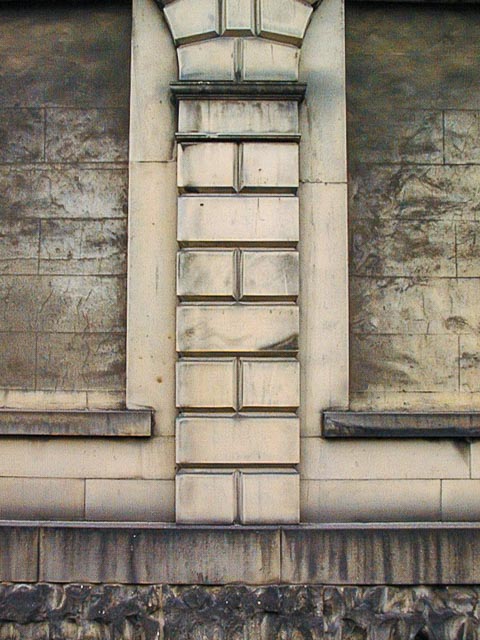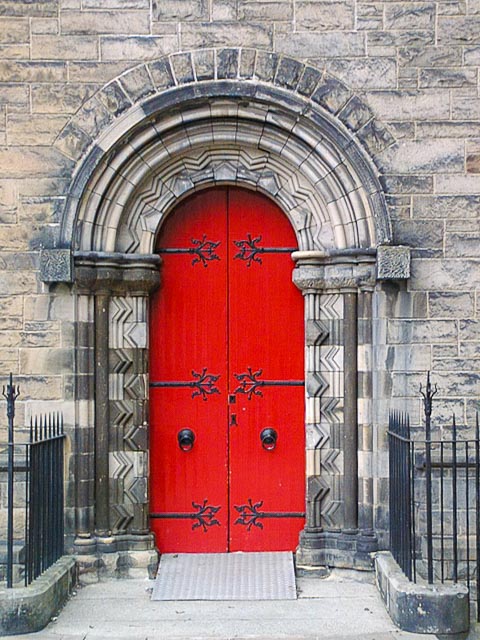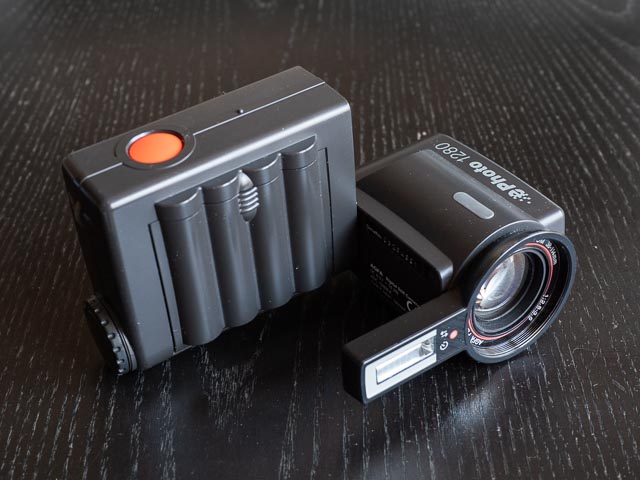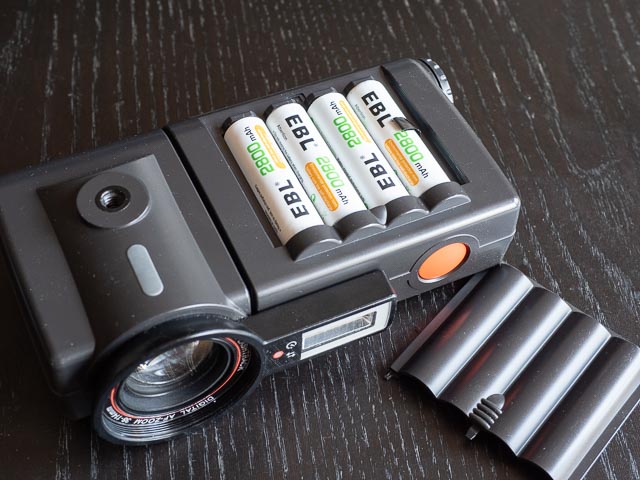Agfa ePhoto 1280
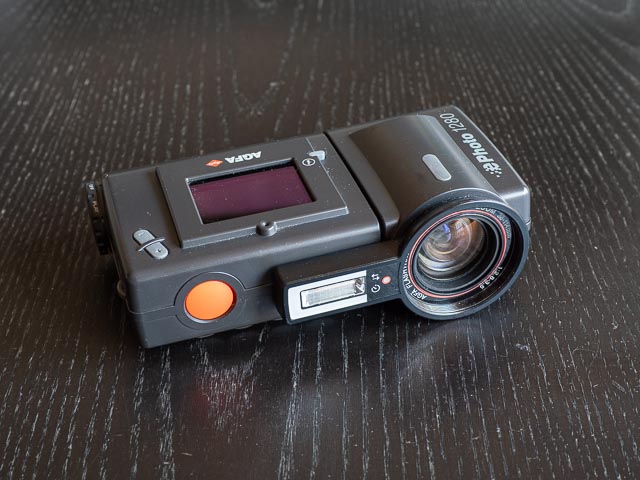
Introduction
| Launch date | October 1997 |
|---|---|
| Camera type | Compact digicam |
| Camera size | 501 grams 156 x 92 x 51 (inc. battery) |
| Sensor type | CCD |
| Sensor size | Unknown |
| Resolution | 1024 x 768 (0.8 megapixel) |
| Memory card | SmartMedia (max. size: 8mb) |
| Battery | AA x 4 |
| Lens | Agfa Flashtrack Digital AF-Zoom 38-144mm 1:2.8-3.5 (35mm equiv. focal length, real focal length not specified) |
If you just want to see some photographs, skip straight to the results section.
At the time the Agfa ePhoto 1280 was launched consumer digicams generally had a resolution of no more than 640 x 480 pixels, or about 0.3mp. Such devices are really more computer novelties than real cameras. At this time, anything more than 0.3mp indicated a high-end device that was at least trying to court the photography enthusiast, and outside of the world of DSLRs costing 10s of thousands of £s, there were precious few of them!
The model name of this camera needs a little explanation… it was common for cameras of this era to include their pixel resolution in their name, and that is the case here. But this was also an era when clear standards about how to report a digital camera's resolution hadn't really been established. So a horizontal resolution of 1280px (and assuming a vertical resolution of 960px for a standard 4:3 aspect ratio) suggests just under 1.3 megapixels, but the actual maximum resolution of this camera's files was in fact 1024 x 786 pixels, which works out at 0.8 megapixels. This camera's highest resolution setting only produced the touted 1.3mp files if you downloaded them to your computer with the "PhotoWise" application supplied with the camera, which performed additional interpolation to increase the horizontal resolution to from 1024px to 1280px. This kind of playing fast and loose with the resolution facts was very common in the late 1990s.
(And I am of course ignoring all the complexities of turning the raw data from a standard digital camera sensor into files you can actually view on a computer screen, a process usually known as demosaicing. Demosaicing requires large amounts of interpolation even if the resulting JPEG file has the same pixel resolution as the camera's sensor, but that's far too complicated to get into here! Just know that this is a 0.8mp camera, not 1.3mp, whatever the model name is trying to make you believe!)
Finding out what such an old camera sold for when new is no easy matter, but this Agfa ePhoto 1280 contemporary review on epi-centre.com suggests it sold for around £649. That might make the ePhoto 1280 sound expensive, but it would have been (by some margin) your cheapest option for a near megapixel camera in 1997! So if you were a photography enthusiast with early adoption tendencies, how close would spending half a month's salary (the average salary in the UK in 1997 was approximately £1300) have got you to your digital photography nirvana in late 90s? In fact, how close will spending 25 quid in 2025 get you?! Let's find out…
Buying a Agfa ePhoto 1280 in 2025
With early digicams becoming more and more collectable, it will perhaps comes as something of a relief to find out that this camera doesn't seem to be on many people's radar, at least not yet. So even though it's a somewhat rare camera, demand is also low, so it shouldn't cost you mega-bucks… In 2025 I paid £27 (including p&p) for my example, in excellent condition, complete with an 8mb SmartMedia card, and in full working order. Batteries weren't included, but since it takes standard AA batteries I already suitable ones in my gear cupboard. A more general search of eBay suggests that you really shouldn't have to pay any more that £40 at the very most.
Just bear in mind that SmartMedia cards aren't all that common these days, and can cost a surprising amount of money, so I suggest asking your vendor if one is included! Also bear in mind you'll need one of the older 3.3 volt cards of 8mb or less.
Using a Agfa ePhoto 1280 in 2025
One of the first things to strike you, at least if you're old enough to remember Agfa's famous line of Optima Sensor film cameras, is that the styling faithfully carries over Agfa's long standing brand identity, particularly with that enormous round orange shutter button!
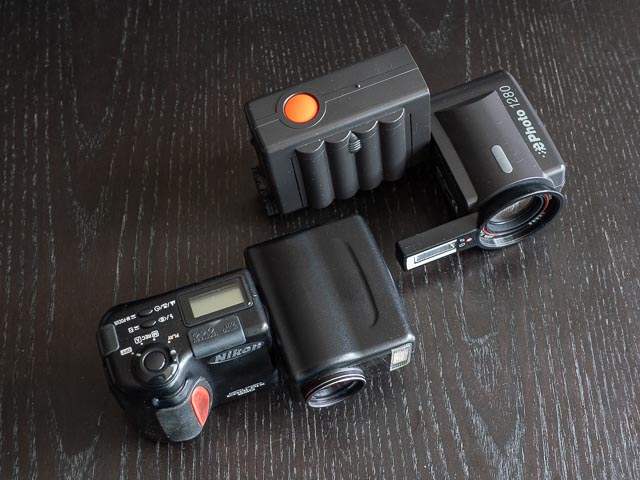
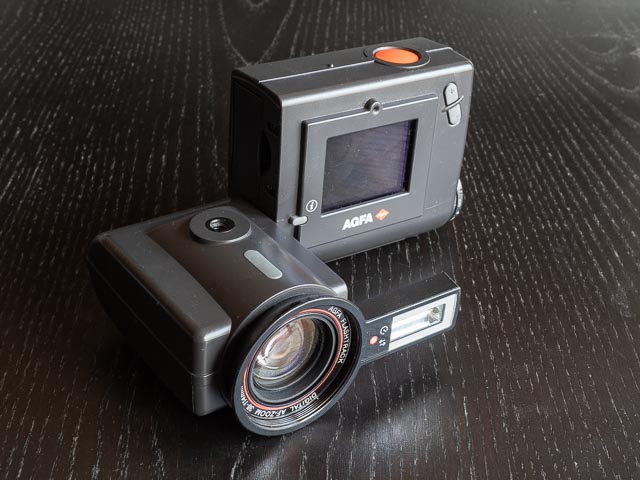 But perhaps the biggest thing is the split body style with one half containing the lens, sensor and flash, and the other half the monitor and controls. The two halves turn around far enough to allow those with a narcissistic streak to get an early start with 1990s selfies! Looks kinda familiar, doesn't it? Maybe Nikon weren't being as original as you thought with their Coolpix 9xx series of cameras! The first of Nikon's split-body cameras (the Coolpix 900) came out almost exactly one year after the ePhoto 1280 in October 1998, but the concept is identical. However one difference is the complete lack of even the simplest tunnel-type optical view-finder on the ePhoto 1280… this camera uses live-view exclusively. Such viewfinders were common on early digicams, and was indeed a feature of the all the Coolpix 9xx series of cameras.
But perhaps the biggest thing is the split body style with one half containing the lens, sensor and flash, and the other half the monitor and controls. The two halves turn around far enough to allow those with a narcissistic streak to get an early start with 1990s selfies! Looks kinda familiar, doesn't it? Maybe Nikon weren't being as original as you thought with their Coolpix 9xx series of cameras! The first of Nikon's split-body cameras (the Coolpix 900) came out almost exactly one year after the ePhoto 1280 in October 1998, but the concept is identical. However one difference is the complete lack of even the simplest tunnel-type optical view-finder on the ePhoto 1280… this camera uses live-view exclusively. Such viewfinders were common on early digicams, and was indeed a feature of the all the Coolpix 9xx series of cameras.
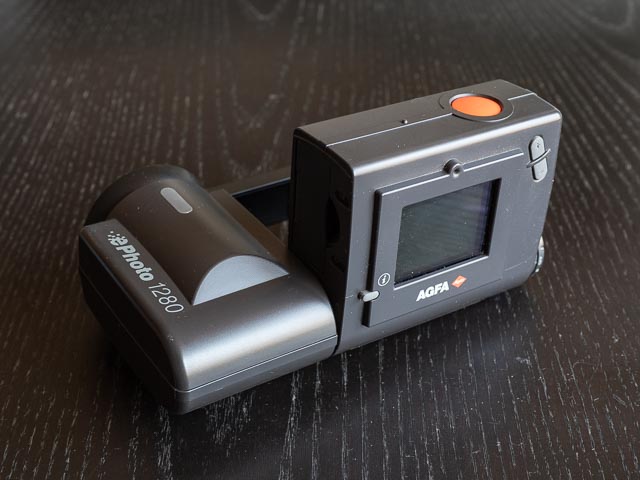 The ePhoto 1280 features the bear minimum of controls on it's body, so a quick tour won't take long. In addition to the huge orange shutter button, on the back of the camera (as set up for normal picture taking) there are really only two controls: on the top right hand side of the monitor is a +/- control used for zooming, and on the bottom left is a small button marked 'i' which is used to overlay some very basic information on the monitor.
The ePhoto 1280 features the bear minimum of controls on it's body, so a quick tour won't take long. In addition to the huge orange shutter button, on the back of the camera (as set up for normal picture taking) there are really only two controls: on the top right hand side of the monitor is a +/- control used for zooming, and on the bottom left is a small button marked 'i' which is used to overlay some very basic information on the monitor.
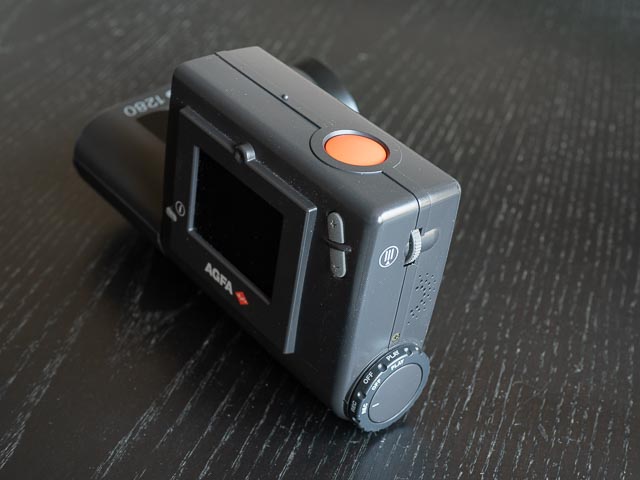 On the right hand side of the camera there are two more controls. At the top is a jog dial that works very much like the jog dial on many Sony digicams (Agfa call it the 'EasyPilot' button). This is used to access and navigate the camera's menus. Push it in to display the menus, push it again to move between the menus and spin it up and down to highlight different menu options, then press it once more to select the currently highlighted option. Toward the bottom of the camera is a mode dial with just three positions: 'Rec' for taking photos, 'Off' and 'Play' for displaying photos already captured on the monitor. And that's your lot as far as controls go!
On the right hand side of the camera there are two more controls. At the top is a jog dial that works very much like the jog dial on many Sony digicams (Agfa call it the 'EasyPilot' button). This is used to access and navigate the camera's menus. Push it in to display the menus, push it again to move between the menus and spin it up and down to highlight different menu options, then press it once more to select the currently highlighted option. Toward the bottom of the camera is a mode dial with just three positions: 'Rec' for taking photos, 'Off' and 'Play' for displaying photos already captured on the monitor. And that's your lot as far as controls go!
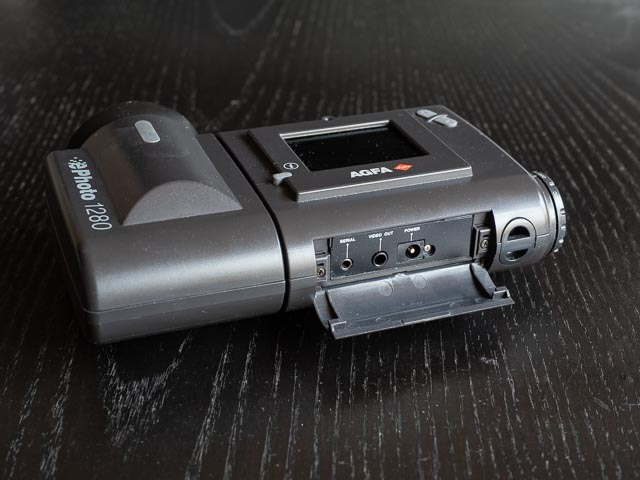
 But we haven't quite finished our tour yet. There's also a door which conceals 3 ports: A serial port for connecting you camera to a computer; a video out port for connecting your camera to a TV, and a port for powering your camera with an AC adapter. Finally, twisting the 2 halves of the camera far enough will reveal the memory card door cunningly hidden between them.
But we haven't quite finished our tour yet. There's also a door which conceals 3 ports: A serial port for connecting you camera to a computer; a video out port for connecting your camera to a TV, and a port for powering your camera with an AC adapter. Finally, twisting the 2 halves of the camera far enough will reveal the memory card door cunningly hidden between them.
What might come as a surprise for a camera with so few external controls is the high level of manual controls the ePhoto 1280 provides, but all manual settings require a time consuming menu deep dive that really discourages anything other than fully automatic shooting. Lets have a look at those shooting menus;
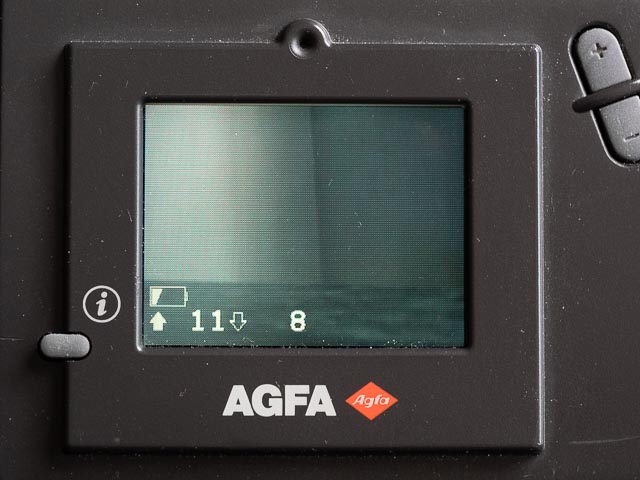
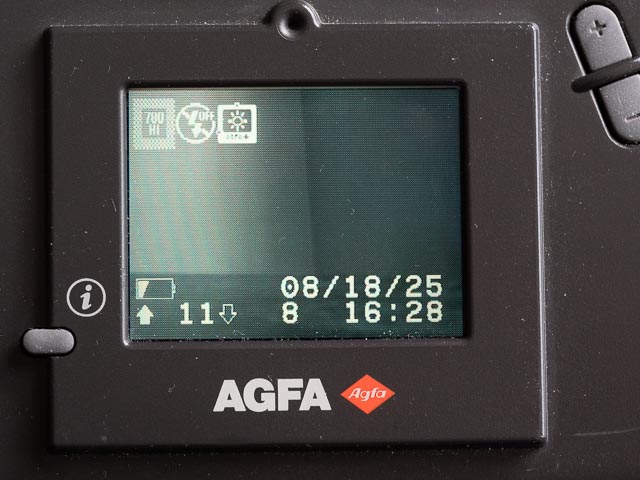 To begin with let's look at what you see when you press the 'i' button in shooting mode. This switches on some very basic shooting information: remaining battery life (looks like my batteries are about to run out!), number of photos already stored on the card, and an estimate of the number of photos for which you still have space is all you'll get. Press it again and date, time and an indicators for image quality, flash mode and preview mode (i.e. whether your in normal or bright mode) are added. Press it a third time and you back in the default mode with no information at all.
To begin with let's look at what you see when you press the 'i' button in shooting mode. This switches on some very basic shooting information: remaining battery life (looks like my batteries are about to run out!), number of photos already stored on the card, and an estimate of the number of photos for which you still have space is all you'll get. Press it again and date, time and an indicators for image quality, flash mode and preview mode (i.e. whether your in normal or bright mode) are added. Press it a third time and you back in the default mode with no information at all.
Hit the EasyPilot button while in shooting mode and you'll get access to four menus:
-
Image quality. This menu has 5 options:
- 780Hi for 1024 x 768 pixel images with low compression
- 780S for 1024 x 768 pixel images with a higher level of compression
- 307Hi for 640 x 480 pixel images with low compression
- 307S for 640 x4 80 pixel images with a higher level of compression
- 1280 for 1024 x 768 pixel images with the lowest amount of compression. These images are tagged so that when you use the PhotoWise application to download your images it will use interpolation to increase the pixel resolution to 1280 x 960. Rather confusingly the user guide for the ePhoto 1280 states that the 1280 image quality setting records 1024 x 960px files, but I can confirm this is a mistake: they really are 1024 x 768px! Needless to say I don't have access to PhotoWise, so I was unable to determine how effective the 1280 image quality mode is.
-
Flash mode. This menu has 4 options:
- Auto
- Fill-in
- Off
- Red-eye
-
Preview mode. This menu has 2 options for controlling the brightness of the monitor:
- Normal for use in normal light levels
- Low light brightens the display for use in low light levels
-
Advanced settings. This is by far the most complex menu as it gives you access to a wide range of manual settings:
- Self Timer Allows the shutter to be released with a 5 or 10 second delayed action.
- Focus Allows focussing to manually set to one of 5 zones
- Exposure Gives access to exposure compensation, aperture priority and shutter priority modes
- White point Allows white balance to be set manually
- Ext. flash Allows aperture and shutter sync. speed to be manually set when using an external flash unit (but I could find no mention in the user guide of how to attach an external flash gun!)
- Date & time
- Automatic Restores all above settings back to automatic
- Exit Exits the menu without setting anything
So yeah... a pretty extensive range of manual settings! But not exactly quick and easy to access. Let's say you want to set your shutter speed manually while the camera continues to set everything else automatically (in other words, shutter speed priority mode). These are the steps you'd have to take:
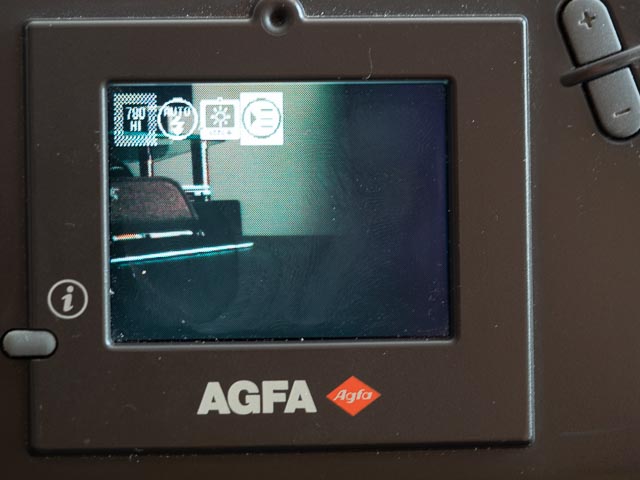 Hit the EasyPilot button to bring up the menus, then navigate to the advanced settings menu, then hit the EasyPilot button again to enter the advanced settings menu
Hit the EasyPilot button to bring up the menus, then navigate to the advanced settings menu, then hit the EasyPilot button again to enter the advanced settings menu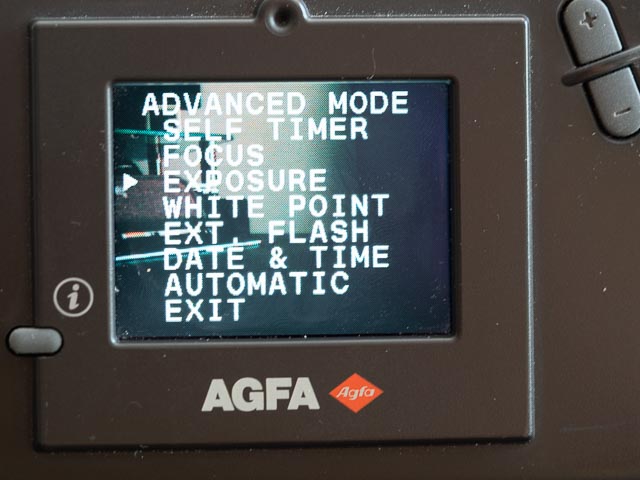 In the advanced settings menu, select the exposure option.
In the advanced settings menu, select the exposure option.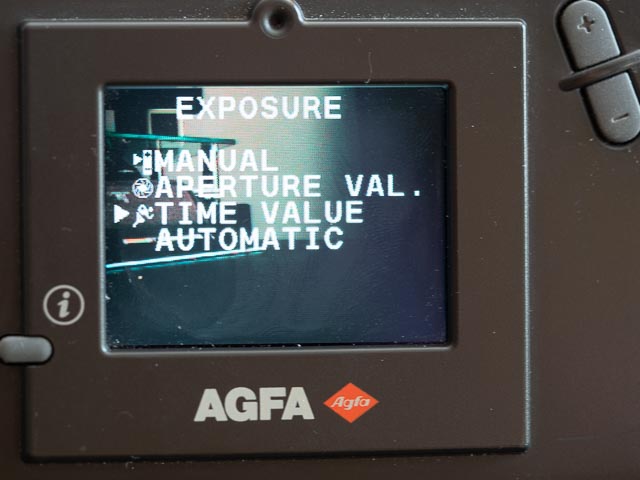 In the exposure menu, select the time value option.
In the exposure menu, select the time value option.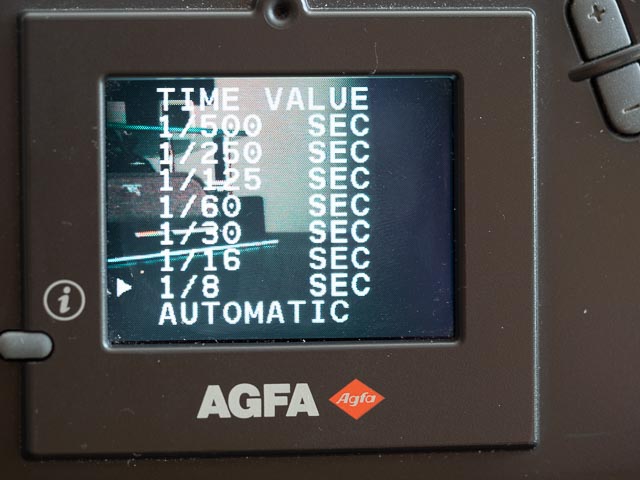 In the time value menu, select you chosen shutter speed. (Note: in the aperture values menu all you see are large, medium and small options, and the manual menu in fact just provides a way to brighten or darken the image, in other words it provides what most cameras would call exposure compensation.) I hope you remembered what shutter speed you set because…
In the time value menu, select you chosen shutter speed. (Note: in the aperture values menu all you see are large, medium and small options, and the manual menu in fact just provides a way to brighten or darken the image, in other words it provides what most cameras would call exposure compensation.) I hope you remembered what shutter speed you set because… … when you are returned to shooting mode, your only clue that shutter speed is no longer being set automatically is the little running man icon. There is no indication of what shutter speed you have selected! And don't forget to reset to automatic shutter speed selection when you're done or all the following photographs will probably be ruined. Fun, huh?
… when you are returned to shooting mode, your only clue that shutter speed is no longer being set automatically is the little running man icon. There is no indication of what shutter speed you have selected! And don't forget to reset to automatic shutter speed selection when you're done or all the following photographs will probably be ruined. Fun, huh? 
Note also that you won't see any hint of ISO or sensitivity in the menus (or in the user guide or in the specifications for that matter). I'm guessing it's around 80ISO, but I can do no more than guess, and whatever it is it can't be adjusted!
But when you're using this camera like I'm sure it was really intended to be used (i.e. in fully automatic mode), what's it like in practice? The thing is, in fully automatic mode, the ePhoto 1280 actually makes a surprisingly pleasant companion for casual snap-shot photography. It stylish, well made and easy to use, and the split body makes it a lot of fun too, as any user of a Nikon Coolpix 9xx series copycat camera will know 
But this is still a 28 year old camera, so easy and stylish it maybe, but quick it is not! Start up time is around 7 seconds and you'll be waiting around 15 seconds before you can take your next shot every time you hit that big orange shutter button! And you be waiting a similar time, watching the image build up line by laborious line, as you advance through your photographs in playback mode too.
I have to say that as a geeky step back in time, I found the ePhoto 1280 a huge amount of fun to use, but it would be just too slow to have persuaded any photography enthusiast to have given up their film camera! So to answer the question posed as the start of this article; would this camera have meant photographic nirvana back in 1997? Err… no… at least, not when it comes to usability, but what about the results?
Agfa ePhoto 1280 results
In one final throw back to the early days of digital photography, the ePhoto 1280 doesn't record any EXIF data at all in it's JPEG files. The EXIF standard for encoding metadata about a digital photograph, such as capture date, aperture, shutter speed, ISO, etc, etc, is so universal these days that it's difficult to imagine a time before every camera in existence didn't record this information, which is why I can't tell you any of the setting used to capture this images.
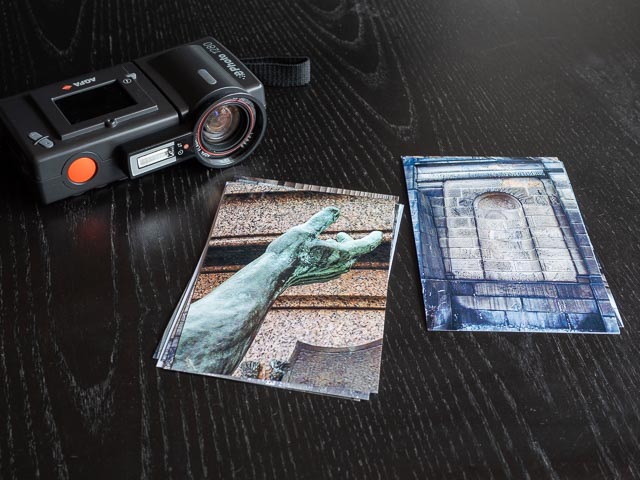 I could have used the 1280 image quality mode, which gives 1024 x 768px images if you just copy them from the memory card without using Agfa's PhotoWise application, but the lowest possible levels of compression, but at the cost of doubling the size of the files (i.e. only around 12 per 8mb memory card!). Instead I shot all my images in the next best 780Hi mode. This give the same 1024 x 768 images as 1280 mode, but with somewhat higher levels of compression, allowing a more practical 24-30 images to be stored on an 8mb card.
I could have used the 1280 image quality mode, which gives 1024 x 768px images if you just copy them from the memory card without using Agfa's PhotoWise application, but the lowest possible levels of compression, but at the cost of doubling the size of the files (i.e. only around 12 per 8mb memory card!). Instead I shot all my images in the next best 780Hi mode. This give the same 1024 x 768 images as 1280 mode, but with somewhat higher levels of compression, allowing a more practical 24-30 images to be stored on an 8mb card.
Overall the images were definitely better than I was expecting, but if I'm being honest, that's mainly because my expectations were pretty low! My most basic standard for calling a camera a real camera, rather than just a computer toy, is whether it can deliver a 150 x 100mm print (what used to be known as an 'enprint' back in the days of film) that wouldn't look out of place in any family photo album. At first glance, the the ePhoto 1280 passes this test, but only at first glance. But I'm not really sure these enprints really stand up to close inspection. Particular on examples with complex textures, they have a subtle but clearly pixelated/compressed quality. Maybe shooting in the 1280 image quality mode for the lowest possible levels of compression would help, but only at the expensive of only being able to fit 12 images on a card.
I think the story is similar when viewed online: the 640 x 480 pixel files below look pretty good, but click on each image to enlarge it and the quality starts to break down, particularly with complex textures. So if the camera was too slow to please a photography enthusiast, would the results have got us to photographic nirvana in 1997?! Err… no… 
 . Not even with the low bar of 150 x 100mm prints!
. Not even with the low bar of 150 x 100mm prints!
But like I said, I did have lots of geeky fun with finding out in 2025! (And have I used too many ellipses in this article…? Let's not go there  )
)

